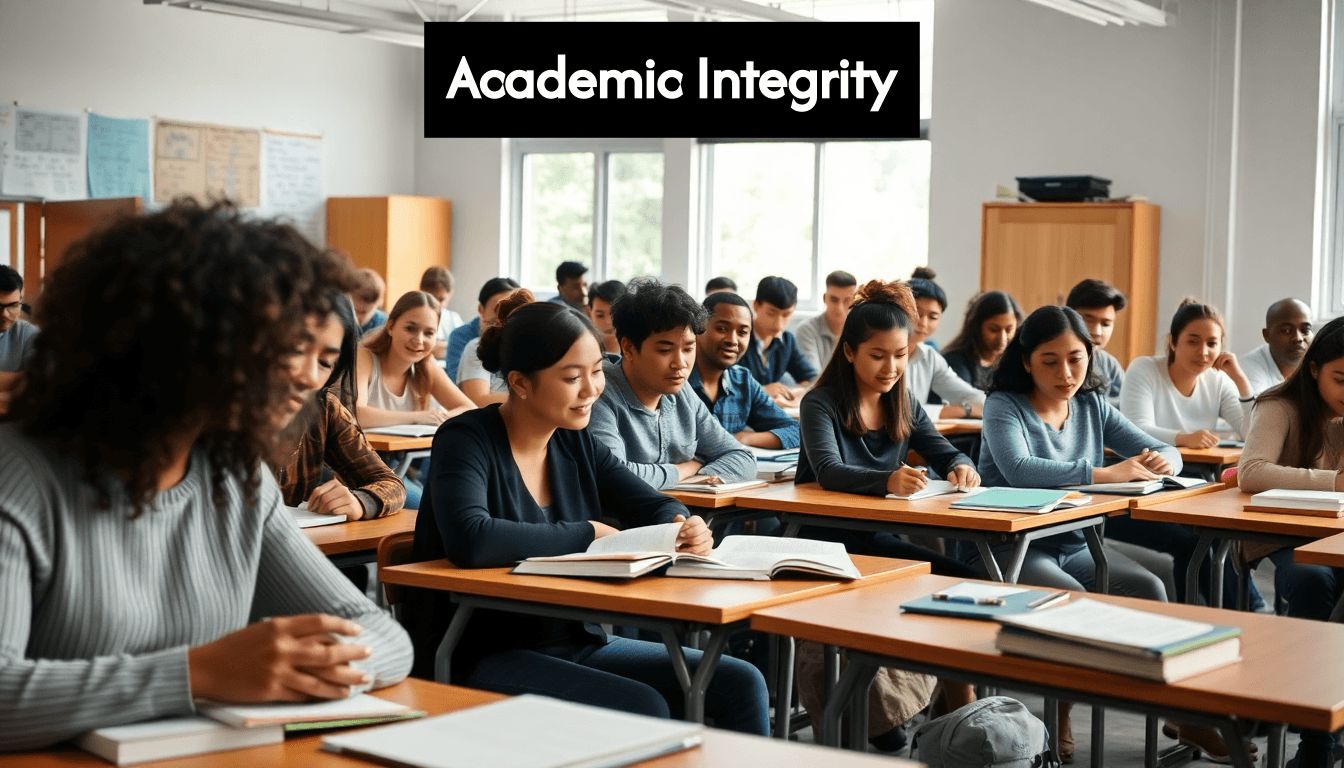Blog
Learning Materials
Understanding Types of Academic Dishonesty: Real Examples & Prevention Tips
Updated: April 16, 2025

Understanding Types of Academic Dishonesty: Real Examples & Prevention Tips

Academic dishonesty is a growing concern in today's educational landscape. With over 60 percent of students admitting to cheating at least once during their academic journey, it's clear that integrity is under threat. But here's the surprising twist: not all academic misconduct stems from intentional deception. Many students unwittingly cross the line due to misunderstandings of complex rules regarding citations and collaboration. Understanding these nuances is critical to fostering a culture of honesty and accountability in education.
Defining Academic Dishonesty
Academic dishonesty encompasses any action or behavior that provides a student with an unfair academic advantage over their peers, compromising the integrity of the educational process. It represents a serious violation of educational standards that undermines the fundamental values of learning, fairness, and intellectual honesty that academic institutions strive to uphold.
Core Elements of Academic Dishonesty
At its essence, academic dishonesty refers to any form of cheating or deception in an academic setting. While specific definitions may vary slightly between institutions, the academic dishonesty meaning generally includes any attempt to gain unearned academic credit or advantage through deceptive or unethical means. This behavior directly contradicts the principles of fairness and intellectual growth that educational institutions are designed to foster.
The definition of academic dishonesty has evolved over time, particularly as technology has transformed how students learn and complete assignments. What constitutes academic dishonesty today encompasses a broader range of behaviors than in previous decades, adapting to new opportunities for misconduct created by digital tools and online learning environments.
According to research from a Canadian online university survey involving both students and faculty, there's a significant need for clear policies and procedures regarding academic integrity, highlighting how important proper definitions are for maintaining educational standards research from Source.
Distinguishing Between Intentional and Unintentional Violations
An important distinction in defining academic dishonesty lies between intentional and unintentional violations. Intentional academic dishonesty occurs when a student knowingly and deliberately engages in prohibited behavior to gain an advantage. This might include bringing unauthorized materials to an exam or purchasing a term paper online.
Unintentional academic dishonesty, on the other hand, often results from misunderstanding citation rules, improper paraphrasing, or lack of knowledge about collaboration policies. While still considered academic misconduct, these cases typically stem from ignorance rather than deliberate deception. Many institutions consider the intent when determining appropriate consequences, though both forms remain violations of academic integrity standards.
Institutional Definitions and Policies
Most educational institutions explicitly define academic dishonesty in their student codes of conduct or academic integrity policies. These definitions typically outline specific prohibited behaviors, ranging from plagiarism and cheating to unauthorized collaboration and fabrication of data.
Institutional policies serve multiple purposes: they educate students about expectations, provide faculty with clear guidelines for identifying and reporting violations, and establish consistent procedures for addressing academic misconduct. These policies also typically detail the potential consequences of academic dishonesty, which may range from assignment failure to expulsion, depending on the severity and frequency of violations.
The academic dishonesty definition at most institutions emphasizes both the ethical dimensions of academic work and the practical expectations for student conduct. By clearly defining what constitutes academic dishonesty, institutions establish a foundation for promoting a culture of integrity and accountability within their academic communities.
Key Takeaways
| Takeaway | Explanation |
|---|---|
| Importance of Clear Definitions | Clear definitions of academic dishonesty help maintain educational standards by setting expectations and informing students of acceptable practices. Institutions should regularly update their policies to adapt to evolving challenges. |
| Distinction Between Intentional and Unintentional Misconduct | Understanding the difference between intentional and unintentional academic dishonesty allows institutions to tailor consequences and educational interventions appropriately, addressing ignorance without discrediting students' intentions. |
| Consequences Extend Beyond Academics | Academic dishonesty can have significant long-term implications, including professional limitations, skills deficits, and damage to self-concept, highlighting the need for integrity throughout educational experiences. |
| Central Role of Faculty | Faculty members are crucial in preventing academic dishonesty through assignment design, clear expectations, and building relationships with students that foster integrity rather than reliance on supervision. |
| Collaborative Responsibility | Academic integrity is a shared responsibility among institutions, faculty, and students, requiring cooperative efforts to cultivate a culture that prioritizes honesty and ethical academic behavior. |
Plagiarism, Cheating, and Fabrication
Among the various types of academic dishonesty, plagiarism, cheating, and fabrication represent the most common and serious violations. Each of these forms undermines educational integrity in distinct ways, though they all share the common thread of misrepresenting a student's actual knowledge, abilities, or effort.
Plagiarism: Theft of Intellectual Property
Plagiarism occurs when a student presents someone else's work, ideas, or words as their own without proper attribution. This form of academic dishonesty represents a violation of intellectual property and academic honesty that spans cultures and disciplines, though interestingly, it wasn't always viewed this way. The concept of plagiarism as immoral and originality as ideal emerged relatively recently in human history—during the 18th-century European Romantic movement according to research.
Common types of plagiarism include:
- Direct plagiarism: Copying text verbatim without quotation marks or citation
- Mosaic plagiarism: Borrowing phrases from a source without quotation marks
- Self-plagiarism: Resubmitting one's previous work for a new assignment
- Accidental plagiarism: Improperly citing sources or unintentionally paraphrasing too closely
While plagiarism and copyright infringement may overlap, they remain distinct concepts. Plagiarism focuses primarily on claiming unearned intellectual credit, while copyright infringement concerns legal rights violations. Many instances of plagiarism don't constitute copyright infringement, yet both represent serious breaches of academic integrity.
Cheating: Unauthorized Assistance
Cheating encompasses a broad range of behaviors where students give or receive unauthorized assistance on academic work. Unlike plagiarism, which specifically involves misappropriating others' intellectual property, cheating can take numerous forms:
Exam-related cheating includes using unauthorized materials during tests, copying from other students, impersonating another student, or unauthorized access to test materials before an exam. The digital era has introduced sophisticated methods like using hidden electronic devices or creating elaborate systems for sharing answers.
Assignment-related cheating typically involves unauthorized collaboration, having someone else complete work, or sharing answers when individual effort is required. This includes paying others to write papers or complete online assignments, a practice known as contract cheating that has grown with the proliferation of essay mills and freelance academic writers.
Fabrication: Creating False Data
Fabrication involves the invention or falsification of information, research, or citations in academic work. This form of academic dishonesty strikes at the heart of academic inquiry by corrupting the factual foundation upon which knowledge is built.
In its most blatant form, fabrication includes:
- Creating fictional data for research projects or lab reports
- Inventing sources or citations that don't exist
- Falsifying research results to support a preferred conclusion
- Altering actual data to better fit a hypothesis
Fabrication is particularly damaging in research contexts, where it can undermine scientific progress and public trust in academic institutions. In student work, it often stems from pressure to produce specific outcomes or from inadequate time management that leaves students scrambling to complete assignments.
The Blurring Lines in Digital Education
The boundaries between these forms of academic dishonesty have become increasingly blurred in the digital age. Online education, artificial intelligence tools, and widespread access to information have created new challenges for maintaining academic integrity. For example, AI writing tools can generate content that blends elements of plagiarism, cheating, and sometimes fabrication, creating complex ethical questions about authorship and originality in academic work.
As educational institutions adapt to these challenges, understanding the distinct characteristics of plagiarism, cheating, and fabrication remains essential for promoting a culture of academic integrity and developing effective prevention strategies.
Digital Misconduct and Collusion
The evolution of technology has transformed academic dishonesty, giving rise to new forms of digital misconduct and enabling more sophisticated methods of collusion. As educational environments increasingly integrate digital tools and online platforms, understanding these emerging types of academic dishonesty becomes essential for maintaining academic integrity.
Technology-Facilitated Academic Dishonesty
Digital technology has expanded the possibilities for academic misconduct far beyond traditional methods. Today's students have access to a vast array of digital tools that can be misused to gain unfair advantages:
Contract cheating platforms operate as sophisticated businesses that connect students with individuals willing to complete assignments for payment. These services have become increasingly professional, offering guarantees, customer service, and even loyalty programs. Unlike simple plagiarism, work produced through contract cheating is often original content created specifically for the student, making it particularly difficult to detect through conventional plagiarism-detection software.
Artificial intelligence tools represent a rapidly evolving frontier in academic dishonesty. Text-generating AI can produce essays, solve problems, and create code with minimal human input. This raises complex questions about authorship and originality. The sophistication of these tools creates challenges for educators in determining what constitutes acceptable AI assistance versus inappropriate substitution of AI for student work.
Electronic communication devices enable real-time cheating during exams through discreet messaging. Students may use smartwatches, miniature earpieces, or specialized electronic devices designed specifically for cheating purposes. The increasing sophistication and miniaturization of these technologies make detection particularly challenging during in-person assessments.
Collaborative Misconduct and Collusion
Collusion represents a specific form of academic dishonesty involving unauthorized collaboration between students or external parties. While collaboration is often encouraged in educational settings, collusion crosses ethical boundaries when it violates the expectation of independent work.
Unauthorized group work occurs when students collaborate on assignments explicitly designated as individual efforts. This might include jointly solving problems, dividing sections of papers among group members, or reviewing and substantially editing each other's work beyond permitted levels of assistance.
Coordinated cheating networks represent more organized forms of collusion, where students systematically share answers or resources across classes or cohorts. These networks may maintain archives of previous assignments, exams, or lab reports, particularly in courses where instructors reuse materials. Some collusive networks operate with remarkable sophistication, using encryption, coded language, or private online platforms to evade detection.
Research suggests that disrupting collusive networks requires mechanisms that specifically target the underlying incentive structures that make such networks beneficial to participants. This approach has proven effective in other contexts where collaborative misconduct occurs according to recent studies.
Boundaries Between Collaboration and Collusion
The line between legitimate collaboration and improper collusion often blurs, particularly in today's collaborative learning environments. Many students genuinely struggle to identify where helpful discussion ends and academic dishonesty begins.
For example, study groups represent a valuable educational practice, but they can cross into collusion when members share complete solutions rather than discussing concepts. Similarly, peer review can enhance learning, but becomes problematic when it involves rewriting another student's work rather than providing feedback.
Clear institutional guidelines about acceptable collaboration are essential, especially as educational approaches increasingly emphasize teamwork and collaborative problem-solving. Instructors must explicitly communicate expectations about independent versus collaborative components of assignments and provide specific parameters for acceptable peer assistance.
Detecting and Preventing Digital Misconduct
Educational institutions have responded to these challenges with new detection methods and preventive strategies. Sophisticated plagiarism detection software now incorporates machine learning to identify contract cheating based on writing style inconsistencies. Some institutions implement secure browser environments that restrict access to unauthorized resources during online exams.
However, the most effective approaches combine technological solutions with pedagogical strategies designed to reduce the motivation and opportunity for digital misconduct. These include authentic assessment designs that require personal reflection or application to contexts specific to individual students, making standardized cheating solutions less valuable and more easily detected.
Consequences of Dishonest Practices
Academic dishonesty carries significant repercussions that extend far beyond the immediate academic setting. When students engage in various types of academic dishonesty, they face consequences that impact their education, future career prospects, and personal development. Understanding these multifaceted outcomes helps illustrate why academic integrity matters fundamentally to educational institutions, students, and society at large.
Institutional Penalties and Academic Standing
The most immediate consequences of academic dishonesty come from the educational institution itself. These penalties typically follow a graduated approach based on severity and frequency of violations:
Course-level penalties often represent the first tier of consequences. These may include receiving a zero on the assignment, failing the course entirely, or being required to complete additional work on academic integrity. Instructors typically have discretion in applying these penalties, though institutional policies may establish minimum sanctions for certain violations.
Institutional disciplinary actions can range from formal warnings to suspension or expulsion in the most serious cases. Many institutions maintain a centralized record of academic dishonesty violations, with repeat offenses triggering escalating consequences. These records may appear on academic transcripts or be accessible to graduate admissions committees, potentially affecting future educational opportunities.
Loss of privileges might include revocation of scholarships, dismissal from honors programs, or removal from leadership positions. Students found responsible for academic dishonesty may also lose eligibility for academic awards, honors designations, or letters of recommendation from faculty members.
Long-term Professional Implications
Beyond immediate academic penalties, dishonest practices can have lasting professional consequences:
Career limitations may emerge when employers discover past academic dishonesty. Many professions—particularly those involving fiduciary responsibilities, healthcare, law, or education—place high value on personal integrity. A documented history of academic dishonesty can raise red flags during background checks or reference inquiries.
Skills deficits develop when students repeatedly circumvent learning through dishonest means. By cheating rather than mastering material, students develop knowledge gaps that may become evident in workplace performance. These deficiencies can impair career advancement and professional effectiveness.
Professional licensing barriers exist in fields that require certification or licensure. Many licensing boards include character and fitness requirements that explicitly address academic dishonesty as potential disqualifying behavior. Law, medicine, accounting, and other regulated professions may deny licensure based on documented academic misconduct.
Psychological and Developmental Impacts
Academic dishonesty also carries less visible but equally significant personal costs:
Ethical development disruption occurs when students routinely engage in dishonest practices. The college years represent a critical period for moral development and ethical reasoning. Habitual academic dishonesty can establish problematic patterns of decision-making that extend into other areas of life.
Self-concept damage happens as students internalize dishonest behaviors into their identity. Research on dishonesty suggests that most people wish to see themselves as honest individuals. Engaging in academic misconduct creates cognitive dissonance that students resolve either by stopping the behavior or by adjusting their self-image and rationalizing dishonesty.
Trust erosion develops between students and faculty. Academic dishonesty violations can permanently alter how instructors perceive a student, potentially limiting mentorship opportunities, research experiences, and the quality of recommendation letters even after penalties have been served.
Institutional and Societal Effects
The consequences of academic dishonesty extend beyond individual students:
Credential devaluation occurs when widespread academic dishonesty undermines the meaning of academic credentials. When degrees are earned through dishonest means, employers and graduate schools may question the value of those credentials for all graduates of an institution.
Educational environment degradation happens as academic dishonesty becomes normalized. Students who maintain integrity may feel disadvantaged compared to peers who gain advantages through dishonest means, creating pressure to abandon ethical standards to remain competitive.
Resource diversion from education to enforcement becomes necessary as institutions implement sophisticated detection systems, conduct hearings, and manage academic integrity cases. These administrative costs ultimately affect all students through increased tuition or reduced educational resources.
Research indicates that many students engage in small dishonest behaviors for various reasons, from pessimism about outcomes to circumstances that increase pressure for success. While major violations with significant negative consequences are less common, even minor dishonesty contributes to a culture that normalizes cutting corners and undermines the educational mission.
Prevention and Best Practices
Preventing academic dishonesty requires a multifaceted approach that addresses both the opportunities for misconduct and the underlying motivations that drive students toward dishonest practices. Educational institutions, faculty members, and students all play crucial roles in fostering a culture of academic integrity.
Institutional Approaches to Academic Integrity
Educational institutions bear significant responsibility for establishing the frameworks that promote academic honesty. Effective institutional strategies typically include:
Comprehensive integrity policies that clearly define various types of academic dishonesty, outline reporting procedures, and establish consistent consequences. These policies should be regularly updated to address emerging forms of misconduct, particularly those enabled by new technologies. Policies are most effective when developed with input from faculty and students, ensuring broad understanding and buy-in.
Honor codes that explicitly state the community's commitment to academic integrity. Research indicates that institutions with well-implemented honor codes typically experience lower rates of academic dishonesty. The most effective honor codes go beyond prohibitions to emphasize positive values such as trust, fairness, respect, and responsibility.
Education and training programs that proactively teach students about academic integrity expectations. These programs are most effective when integrated throughout the curriculum rather than limited to one-time orientation sessions. Training should address both the ethical dimensions of academic integrity and the practical skills needed to avoid unintentional violations, such as proper citation practices.
Detection and reporting systems that balance technological solutions with human judgment. While tools like plagiarism detection software serve important roles, over-reliance on automated systems can create adversarial relationships between students and faculty. The most effective approaches combine technological detection with clear communication about expectations and supportive interventions for first-time or minor violations.
Faculty-Driven Prevention Strategies
Faculty members serve as the frontline in preventing academic dishonesty through their course design, assessment strategies, and classroom practices:
Assignment design represents one of the most powerful tools for preventing dishonesty. Assignments that require personalized responses, application to current events, or integration of personal experiences are inherently more difficult to outsource or plagiarize. Regularly refreshing assignment prompts and avoiding reuse of the same assessments year after year reduces opportunities for dishonesty.
Assessment variety helps address different forms of academic misconduct. Over-reliance on high-stakes exams can increase pressure to cheat, while exclusive use of take-home assignments may facilitate unauthorized collaboration or plagiarism. A balanced approach might include in-class writing, project-based assessments, oral presentations, and proctored examinations.
Relationship building with students creates environments where academic integrity is valued intrinsically rather than maintained through surveillance. When students feel connected to their instructors and invested in their learning, they report lower rates of academic dishonesty. Simple practices like learning student names, offering accessible office hours, and demonstrating enthusiasm for the subject matter can strengthen these connections.
Clear expectations communicated repeatedly throughout the course help students understand both what constitutes academic dishonesty and how to avoid it. Effective faculty members discuss academic integrity when introducing assignments, provide examples of proper and improper practices, and offer opportunities for questions about specific situations students might encounter.
Student-Centered Prevention Approaches
Students themselves play critical roles in preventing academic dishonesty through personal practices and peer influence:
Time management skills help students avoid the pressure-induced dishonesty that occurs when deadlines approach and preparation is inadequate. Teaching specific strategies for breaking down large assignments, scheduling regular study sessions, and prioritizing academic responsibilities can reduce last-minute desperation that often triggers cheating.
Study groups and legitimate collaboration provide support while maintaining academic integrity. When students understand the boundaries between acceptable collaboration and collusion, they can benefit from peer learning without crossing ethical lines. Explicit guidelines about when and how to work together help maintain these distinctions.
Peer accountability creates powerful social norms that discourage academic dishonesty. Student-led honor councils or integrity committees can be particularly effective in promoting a culture where misconduct is socially unacceptable. These peer-driven approaches recognize that students are often more influenced by their peers than by institutional authorities.
Technology and Security Measures
As digital forms of academic dishonesty evolve, technological countermeasures become increasingly important:
Secure testing environments utilize browser lockdown technologies, randomized question banks, and time limits to reduce opportunities for unauthorized assistance during online exams. However, creating completely secure digital assessment environments remains challenging, with determined students often finding ways to circumvent restrictions.
Authentication procedures like identity verification and biometric monitoring aim to ensure that the enrolled student is actually completing the work. These approaches must balance security concerns with privacy considerations and accessibility needs. Strong research suggests that the arms race between security measures and circumvention techniques parallels broader cybersecurity challenges, where complete prevention is difficult to achieve.
AI-aware assessment design addresses the specific challenges posed by artificial intelligence tools. As AI text generators become more sophisticated, assessments that require in-person components, emphasize process documentation, or focus on in-class application of knowledge may become increasingly valuable in ensuring authentic student work.
Effective prevention of academic dishonesty ultimately depends on creating educational environments where integrity is valued as an essential component of learning rather than viewed as an externally imposed restriction. When institutions, faculty, and students work together to cultivate academic honesty, they strengthen not only the credibility of academic credentials but also the fundamental purpose of education itself.
Frequently Asked Questions
What are the main types of academic dishonesty?
Academic dishonesty primarily includes plagiarism, cheating, and fabrication. Plagiarism is presenting someone else's work as your own, cheating involves unauthorized assistance, and fabrication refers to falsifying data or information.
How can academic integrity be maintained in digital learning environments?
To maintain academic integrity in digital settings, institutions can implement secure testing environments, provide clear guidelines on acceptable collaboration, and educate students on academic integrity policies. Regular updates to these policies can also help address emerging digital misconduct trends.
What distinguishes intentional from unintentional academic dishonesty?
Intentional academic dishonesty involves knowingly engaging in dishonest behavior for personal gain, while unintentional academic dishonesty often results from misunderstandings, such as improper citation practices or lack of knowledge about collaboration rules.
What are the consequences of academic dishonesty?
Consequences of academic dishonesty can include course failures, disciplinary actions such as suspension or expulsion, long-term professional implications, and damage to a student's self-concept and trust with faculty members.
Elevate Your Academic Integrity with Samwell.ai
Academic integrity is vital in today’s educational landscape, where the pressures to succeed can lead students to deliberate or unintentional academic dishonesty. As discussed in the article, understanding the distinctions among plagiarism, cheating, and fabrication is key to maintaining ethical standards.
Feeling overwhelmed by essay writing, citations, and the looming threat of academic misconduct?

With Samwell.ai, you’re not alone. Our platform empowers students and academics to create original content while effortlessly adhering to integrity standards. Enjoy features like:
- Automated, plagiarism-free writing
- In-text citations in APA, MLA, and Harvard formats
- Guided essay outlines that not only help you write well but also ensure your work is distinctly your own.
Don’t compromise your academic journey. Explore how Samwell.ai can redefine your writing experience and support your commitment to academic honesty. Start your journey at Samwell.ai today!
Generate essays with Samwell.ai
Whether you’re a publisher, professor, journalist, or student, let us tailor a plan just for you.Most Read Articles

Your Guide to Help Writing a Essay Successfully
Expert tips for help writing a essay - from crafting a thesis to structuring your essay effectively.

How to Write Critical Thinking Essay: Expert Tips
Expert tips for writing a critical thinking essay. Learn how to structure, choose topics, and use evidence effectively.'

How to Write a Good Hook: A Step-by-Step Guide
Master the art of crafting a good hook with our guide. Create compelling openers for a memorable first impression.

